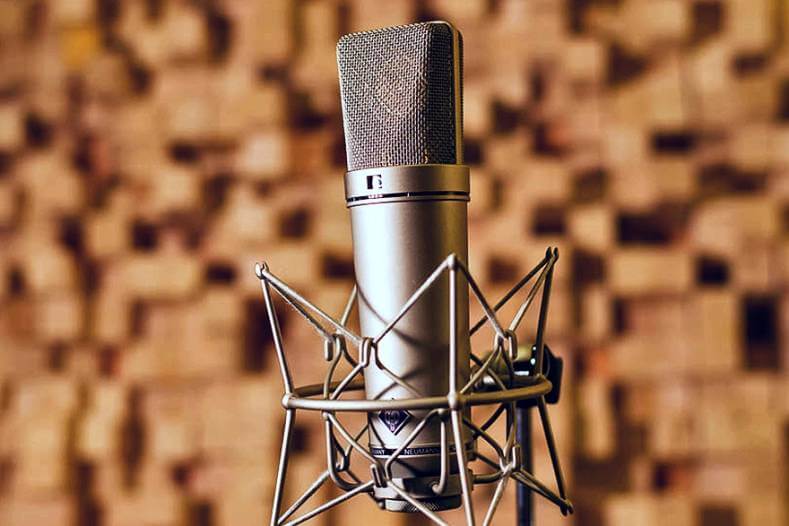
(clickable navigation)
Why Use A Condenser Microphone?
If you’re on the hunt for a new microphone, or you are just curious about microphones, it’s useful to understand what a condenser microphone is, and how it differs from a dynamic microphone. Condenser microphones have been widely used in the recording industry for many years and are a staple of most recording studios. We’ll answer all of your burning questions about condenser microphones right here. Let’s start by learning what a condenser microphone is and how it operates.
Though dynamic microphones are common for stage use, condenser microphones have long been the chosen model for studio recording. This is why:
Condenser microphones need to be powered by a battery or an external source. The resulting audio signal is stronger than that generated by a dynamic mic. Condensers are often more receptive and attentive than dynamics, which makes them ideal for catching subtle nuances in a tone. They are not as suitable for high-volume recording sessions due to being very sensitive, which often causes distortion if you are not careful with mic placement & setup.
The term condenser refers to a capacitor, which is an electrical device that stores energy in the form of an electrostatic field. ‘Condenser’ is technically outdated and no longer used outside of audio, but the term has stuck as the name for this kind of microphone, which uses a capacitor to transform acoustic energy into electrical energy.
Condenser microphones are typically more expensive than dynamic microphones. Less costly versions are available, but usually come at the price of low quality so keep that in mind – you get what you pay for.
A gold-sputtered Mylar diaphragm condenser microphone capsule.
The back-plate is made of sturdy brass and features a hole pattern that must be drilled with great accuracy to insure a clear tone.
A capacitor consists of two plates connected by a voltage. All of these plates located within the condenser mic are made of very light material serving as the diaphragm.
When sound waves strike the diaphragm, it vibrates, changing the distance between the two plates. As a result, the capacitance increases and a charge current occurs as the plates are closer together. Capacitance reduces as the plates are moved apart, and a discharge current occurs.
Condenser microphones are widely used in recording studios to capture sounds with excellent precision, accuracy, and clarity. Great for a range of instruments, vocals, and high frequency recordings. They have a diaphragm that can follow sound waves in a more reliable way than dynamic mics due to their low density. Because of this, Condenser microphones have remarkable sound clarity.
They also have the broadest frequency response and greatest transient response out of all microphone types. Transients are the sharp and short bursts of energy like the sound of a guitar pick plucking strings on an acoustic guitar, or the attack and punch from drumsticks hitting drums and symbols. Due to this, condenser microphones also have better sensitivity and less noise than dynamic microphones.
If you’re using a condenser microphone for vocals, you’ll need a pop filter because they’re so vulnerable to transient noises that the p and sh (plosive) sounds you produce can create distortion and be exaggerated in the recordings without them.
Condensers such as the AKG C414 get their character partly due to them requiring phantom power (power from an external 48V preamp). This means they won’t need a lot of preamp gain to boost the signal to where you want it. Having the wrong type of mic can mean that you need a lot of extra gain and condensers help solve this problem.
Condenser microphones are classified into two types: small and large diaphragm.
Condenser Microphones with a Large Diaphragm
Large Diaphragm Condenser (LDC) microphones such as the Bluebird SL mic are often used for studio vocals and any instrument recording that needs a deeper voice. A large-diaphragm microphone warms up the sound of what it’s transmitting, which contributes to the misconception that most LDC’s reproduce low frequencies better than small diaphragm mics. Small-diaphragm microphones, in particular, are much better at reproducing anything equally, including bass.
Condenser Microphone with a Small Diaphragm
Small Diaphragm Condenser microphones are the perfect option for capturing stuff like stringed instruments because they have a strong, wide-frequency response and the best transient response. SDC’s are still the main method for concert recording.
What is a condenser microphone? Condenser (or capacitor) microphones such as the Neumann U87 are widely used in recording studios to capture sounds with great precision and accuracy. This is achieved by suspending a lightweight membrane (referred to as the diaphragm) by a fixed plate. Sound pressure acting on the diaphragm allows it to move, resulting in electrical output.

Angela Garner is the owner of AudioTrove. She has extensive knowledge of professional audio engineering and studio equipment due to her vast experience in producing.
My name is Angela Garner. I have a passion for audio and music production, since I started working in a recording studio as a young teen. I decided to create a review site about microphones to help pay off my music degree as well as provide Australians with useful information about the best products they can buy.
Each of my product reviews receives a score from 1-100, with 100 being the best reviewed products.
I have a passion for clean reviews, so you will never be burdened with ads on my site. You can support me and this site by clicking on the links for the products, which are Amazon affiliate links, which will pay a small commission on your purchase from there.
I spend an average of 10 to 20 hours reading reviews from consumers for each microphone product I review.
Each microphone and audio product reviewed, will have simple pros & cons to save you time in your search.
Over 10,654 reviews from all over the internet have been read, researched and compiled by AudioTrove®.